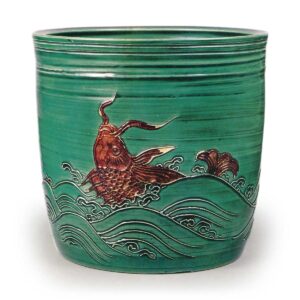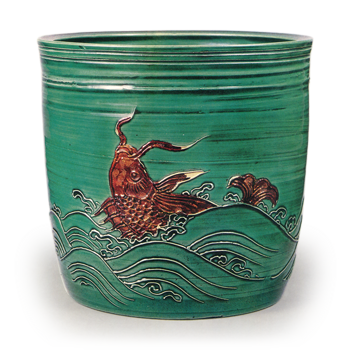
Height 15.7cm, Diameter 15.6-16.2cm, Base Diameter 12.9cm
The so-called Kōchiyaki copies of the Kyoto ware of the end of the Edo period began with Eikawa, and Kimai and Hozan each left behind works with their own distinctive characteristics. In particular, the Kōchiyaki copies of Hozan are more like Japanese-style versions of the Chinese-style Kōchiyaki than the Chinese-style Kōchiyaki, and many of them have a Japanese-style feel. The colored glaze used on them is also very vivid, and they can be said to be the most elegant of the Kyo-yaki Koji-sho pieces from the end of the Edo period.
This is a simple cylindrical water jar with a single-layered mouth, but the two sides of the body are decorated with a wave pattern of koi carp frolicking in the waves, or “araiiso” pattern, expressed using raised lines , and the koi are coated with a lacquer that resembles the sandalwood lacquer technique of urushi-gei, with a base of gold leaf and a top coat of amber-colored lacquer, and the entire surface is covered with green glaze, the color of which is truly vivid. The flat bottom clearly shows the marks left by the thread cutting, and the seal of the Hozon family is stamped in the center. It is stored in a matching box, and on the front is written “Koji ware, Ariso water jar”, on the back is written “Hozon-zukuri”, and the seal of the Hozon family is stamped. It is a work with a bright and elegant appearance, and it shows the originality of Hozon, who made Chinese fohua into a Japanese style.



